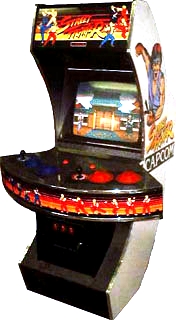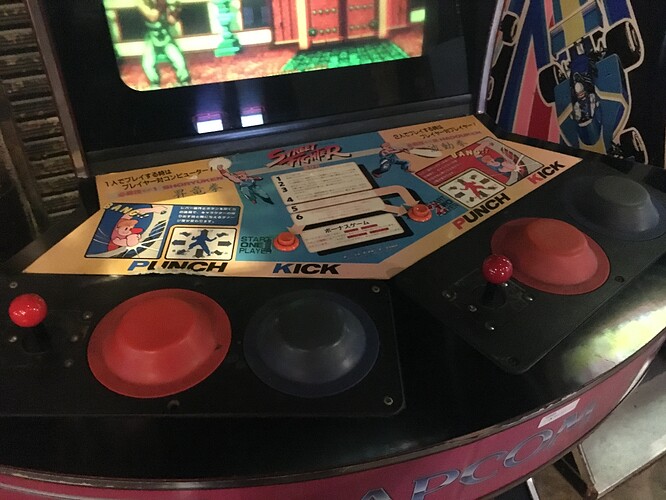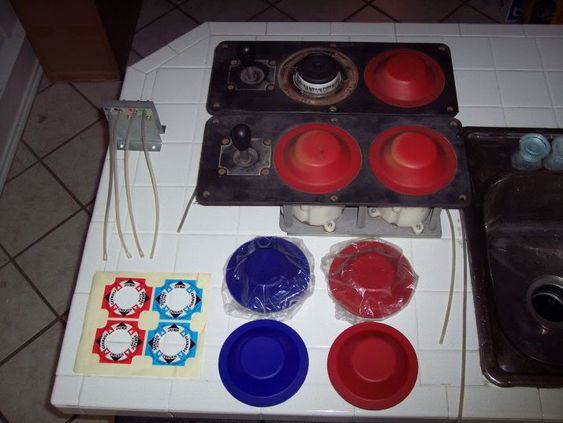(Darksakul for hereon, “you”)
And you missed the point.
Those are not 2 bit analog buttons. The software for the game recognizes 4 states , No Pressed, lightly pressed, medium press and hard press. And when it found those buttons break too quickly they went with a 6 button system, each kick and punch having a low, medium and heavy.
Tripletopper responding (from here on “Me now”)
They are 2 bit analog buttons. The number of bits of sensitivity determine the bit range of the buttons. 2 to the second is 4, there are 4 positions, unpressed, light, medium , and heavy Therefore, regardless of the technology, they are 2 bit buttons because there a 4 or 2 to the second, states it can be in, even though it might have been an analog strength test button that reads at 3 checkpoints for the purposes of the game.
tripletopper: (this refers to DarkSakul quoting me)
and gradually added multi-presses, the first being Zangief.
(you)
The hell you got this lie from. Zangeif was not even seen till SF2.
(Me, Now)
The point is that in SFI you couldn’t press both light punch and medium punch at the same time, because the code of all SFI’s was the same, regardless of whether it had 6 individual buttons or 2 2-bit buttons. There might have been some slight error catching codes for the 6 button version as to what to do if more than one button is presses, but they didn’t add new functionality for QP+MP+HP. Something unpredictable happens if you press any 2 or 3 punches at once. And the first character to have a simul-press button was Zangief in SFII, which does predate Mortal Kombat and Eternal Champions, but SFI with the 6 button arrangement didn’t have simul-press attacks, even though it was physically possible on the 6-button edition, I don’t know how the code interprets it.
tripletopper:
Mortal Kombat and Eterenal Champions use
(you)
These games didn’t came til way after SF II. SF1 was quickly forgotten, SF2 which opened the arcade scene and the video game industry to Fighting games.
(me now)
Just stream of consciousness, I was going to say one of them introduced the multipress, then I thought about Zangief had a multipress in SFII which I know predates the other 2. So I took that back. And I just backtalked my way out of it, instead of erasing it and editing it.
tripletopper:
But chances are no one would buy a SF1 joystick, unless the 30th anniversary collection has SFI Deluxe, where the 10 CPU-controlled characters can be played by humans, and Ryu and Ken controlled by CPUs.
(you)
Still got no idea where you getting this from where the only playable characters was Ryu and Ken, and Ken was only playable as Player 2.
(me now)
I agree very few people would buy a joystick JUST for SF1 “as it was in the arcade” (meaning 1up was Ryu, 2up was Ken, and the CPU played everyone BUT them.). I was suggesting a hypothetical SFI Deluxe. A couple people made hack of SFI which let you play as the other 10 fighters. But if such a hack were legitimized by Capcom, and the balance issues were worked out so it’d be a 30-70% chance any one can win against any other matchup, that would be a good enough excuse to sell fight sticks that can be used for ALL the street fighters including the 2 bit analog buttons in, the again hypothetical, SFI Deluxe, even though it could be technically used for SFI arcade version, either the analog button version as well as the 6 button version, but SFI Deluxe would sell it as a more popular accessory to get than otherwise wouldn’t be before. And 2 bit analog buttons are digital (or 1-bit) button compatible, just press with medium strength and the grossest bit registers a press of 3P and 3K
tripletopper:o
But if you’re going to design something new, do it right. A lot of people consider the 7th and 8th buttons so much of a nuisance
(you)
Still where are you getting this from. No one seen a 7th or 8th button used until the PS3/ Xbox 360 era.
Yeah the Saturn sticks had 8 buttons but they aren’t used or did short cuts to menu functions.
(me now)
The Saturn and Playstation used all 8 buttons, the other 2 buttons being 3P and 3K. Some tournaments insist you turn those off because they believe it’s a skill to press all 3 within a 30th of a second and L supers and r supers are too easy to hit compared to Q+M+H supers. I know this becasue on WCG Ultimate Gamer season 1, the in house rule was only 3 buttons can be used for Virtua Fighter 5, and Sega’s Virtua Fighter series fundamentally uses 3 buttons most of the time, punch, kick, and block. (VF3 is an exception with its 3D button) If you wanted to pull off big moves using 2 or 3 buttons, you better press them all at once. No cheap X, Y, Z, L, or R in this advanced tournament.
As for people taking them off, I’ve seen sticks with flat blank underboard where the 7th and 8th button are. They modded it because they like their pinkies to rest flat, and not on buttons.
tripletopper:
There is another advantage to that. If it were like the SF15 Anniversary stick, with a rectangular arrangement of the buttons, then it could be easily designed to be ambidextrous.
(you)
Never was the case. Also irrelevant to the topic. Nintendo/Sony.Microsoft never authorized an ambidextrous stick any where from the 90s going forwards. You saw some 2 button console sticks being ambidextrous, but they fade out of use in the miod to late 80s.
(me)
My point is with a rectangular arrangement you could have an ambidextrous setup, rotate the unit 180 degrees, swap jump and duck, swap left and right, and swap punches with corresponding kicks. That’s an easy way to make an ambidextrous joystick. And to beginners, some intermediates, and basically anyone who doesn’t know what they’re doing in the custom stick world, to the corporate world, an ambidextrous stick is more attractive a feature and a more obvious benefit than the slight curving of buttons, where companies own rights to specific button contours, and there is argument about whihc contour is best for which game, etc. Enough people think video gaming started with Nintendo and always assumes the stick was in the left hand and never questioned it. But since I played games pre-crash, there were options on some machines, and on those, I gravitated to stick right.
tripletopper:
And Nintendo, Sony and Microsoft can be (Let’s keep this conversation rated E) stubborn idiots when you tell them, you’d LIKE to buy factory authorized, but they make you feel like a criminal for
(you)
Never was the case.
(me now)
You call tech support, tell them you want a right handed version of a stick, tell them you’d like to keep it authorized, but none of their licensees offer a right handed stick, and they tell you the USB ports could be ruined if you get one built, even with factory authorized parts for pad-hacking. Even though Sony and others could void the warrantee for unauthorized controllers in their own standard, they couldn’t for the Guncon 2 because it was USB and they don’t own the USB standard. So it got a PS logo on the game, but not the game and gun pack, and the game and gun pack had the logo on the picture of the game box within the gun pack game box, but the PS logo wasn’t prominent on the Main gun box.
tripletopper:
The only 2 I know of are the Sega Master system Joystick, and they screwed that up because most games make sense mapping index-to-index, not left-to-left, (example Sidearms, Tuthankam) and you might need to do left-to-left too occasionally, and Beeshu Joysticks, which were Authroized for the Turbo Grafx 16, but were unauthorized for Nintendo, and Sega didn’t have a Master System accessory licensing policy in the US. I don’t know whether they were unauthorized, because Nintendo didn’t allow a right handed stick, or whether Beeshu didn’t want to pay licensing fees. Sega was like that on the Saturn until units were left in stores languishing, and Sega on the
(you)
Oh The Nintendo did have plenty of ambidextrous joysticks for the NES and Famicom. They were all two button controllers, with the joystick int he middle and the two buttons are repeated on both sides.
(me now)
But none of them were authorized by Nintendo of America. the only AUTHORIZED (at least in the US) right-handed stick was the Sega-made SMS stick, and Beeshu’s TG16 authorized stick.
tripletopper:
But the point is people are paying big bucks for a joystick,
(you)
Thats how a niche scene is, don’t like it find a different hobby.
(me)
Not complaining, just saying there’d be a little more room of innovation, and some people thought that releasing multiple fight sticks by the same company with nothing different other than a picture difference on the table-top was a wise idea and considered a way to expand the market.
tripletopper:
This will work if these 3 conditions are fulfilled: 1. Pressing buttons with variable pressure is a harder skill than pressing different buttons 2, there is a strategic reason why you’d want to throw lights and mediums in SFI and get past the noob strereotype of harder is always better, and 3. If they make it worth picking up this stick for SFI, by making it SFI Deluxe, with all characters controllable by either Human OR Computer.
(you)
Except only two characters were ever playable, and Ryu was player 1 and Ken was player two.
Moves were not an advertised feature and was hidden features/Easter eggs.
(me now)
Again I’m talking about a hypothetical Street Fighter I Deluxe, not a literal arcade translation. I know the arcade 1up was Ryu, 2up was Ken, Ryu and Ken were more original than Mario and Luigi palate swaps but were functionally just identical palate swaps, and the CPU controllerd everyone else.
As for moves being easter eggs. There were easter eggs and made the game easy if you were casual and didn’t know the moves. I think the arcade machine hinted at he fact that there were secret moves, but didn’t specify. Now the cat’s let out of the back, heck even shoryuken.com 's name and logo is aboutt he dragon punch move in its title, let’s not pretend it’s before 1990 and make a good game for now.


